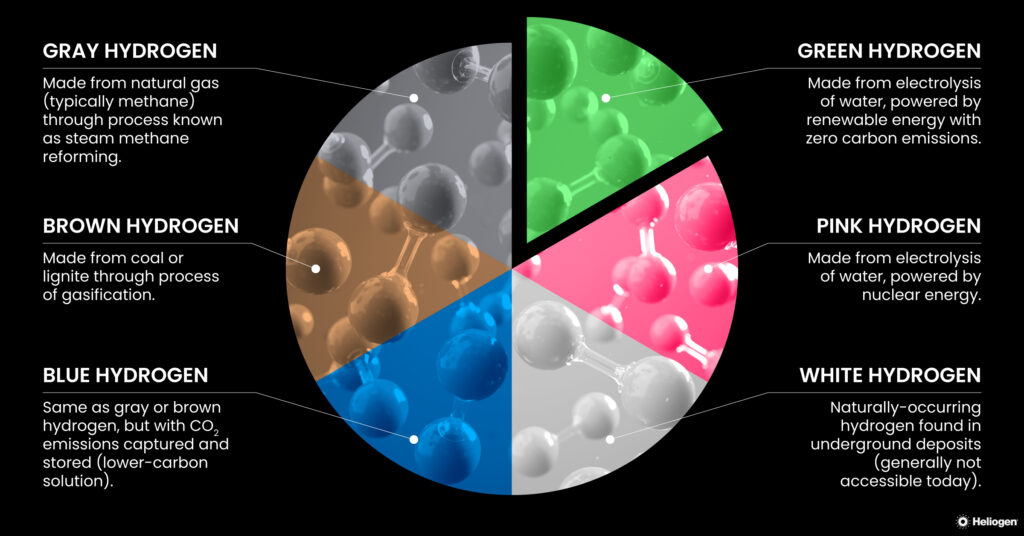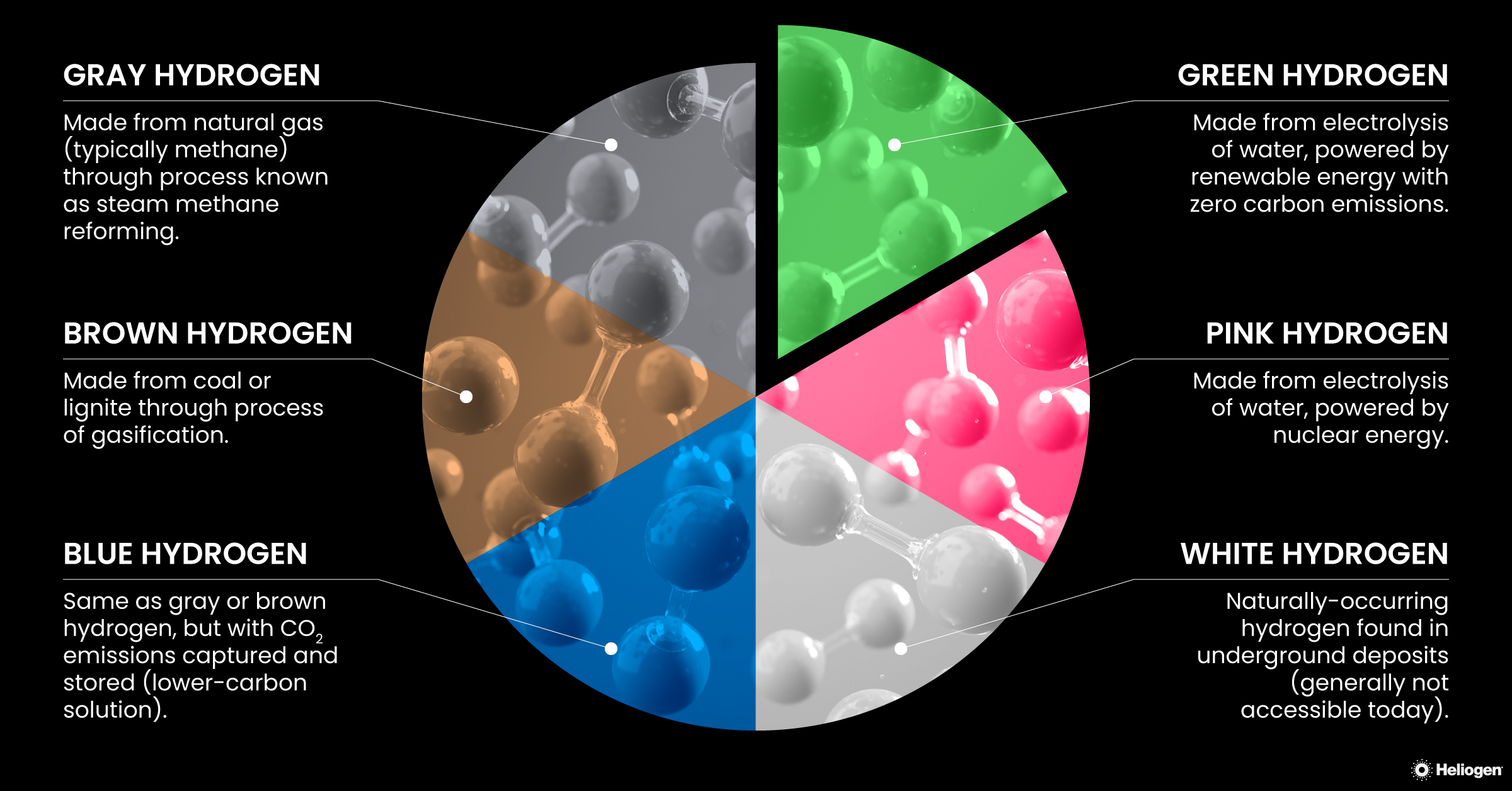Heliogen is working to empower a sustainable future by unlocking the power of sunlight to replace fossil fuels. Today, a massive opportunity exists to decarbonize the industrial sector and lower emissions from transportation. Green hydrogen could be the answer.
Why hydrogen?
Hydrogen is a powerful, transportable energy carrier that can produce electricity, power industry, and enable transportation. Unlike fossil fuels, when hydrogen is burned, it generates only water as a byproduct, meaning no harmful greenhouse gas emissions. For this reason, it is an attractive fuel for the future.
But not all hydrogen is created equal. While hydrogen is the most common element in the universe, it generally does not exist by itself in nature. Molecular hydrogen is produced by splitting hydrogen from fossil fuels, plants, or water. Depending on the raw materials and process used, the hydrogen produced is labeled with a color designation.
What are the “colors” of hydrogen?
“Gray hydrogen,” the most common form of hydrogen available today, is made from natural gas (typically methane). In a process known as steam methane reformation (SMR), methane and steam react together in a high-temperature, high-pressure catalytic reactor, and hydrogen is produced. Carbon dioxide is a pollutant resulting from the steam methane reformation process, making gray hydrogen the least sustainable form of hydrogen available today.
“Blue hydrogen” is produced in much the same manner as gray hydrogen, but the emissions generated from SMR are captured and stored underground in a process known as carbon capture and storage (CCS). While blue hydrogen is a lower-carbon option than gray hydrogen, it is still associated with consequences deriving from the use of fossil fuels, such as the release of methane into the atmosphere.
“Green hydrogen” refers to a 100% clean solution. Green hydrogen is produced using renewable energy sources like solar and wind. Today, less than one percent of total annual hydrogen production is “green,”1 but this is expected to grow as the infrastructure needed to create it is expanded and production costs continue to fall.
Other color designations for hydrogen also exist, such as pink (produced using nuclear energy), black/brown (produced using coal or lignite), and white (naturally-occurring).

How is green hydrogen produced?
Unlike gray hydrogen, green hydrogen is fully renewable in both its source material and its energy supply. For source material, green hydrogen today is typically generated from water through a process known as electrolysis, which uses an electric current to split water into its component molecules of hydrogen and oxygen. This is done using a device called an electrolyzer, which utilizes a cathode and an anode (positively and negatively charged electrodes). This process produces only oxygen – or steam – as a byproduct. As for energy supply, to qualify as “green hydrogen,” the source of electricity used for electrolysis must derive from renewable power, such as wind or solar energy.
There are three main kinds of electrolyzers: alkaline, proton exchange membrane (PEM), and solid oxide. These vary in the nature of the electrolyte material used. Alkaline electrolyzers utilize an aqueous solution with an alkaline-like salt to enable electrical conductivity, while PEM electrolyzers use a solid polymer membrane (electrolyte). Solid oxide electrolyzers use solid ceramic material as the electrolyte, which enables them to operate at higher electrical efficiency and much higher temperatures. This permits the use of steam and external heat as energy sources rather than relying on electricity. Thus, solid oxide electrolysis enables significantly lower cost of operations, since heat is typically less expensive and is sometimes naturally produced as a byproduct of certain industrial processes.
At Heliogen, we are partnering with Bloom Energy (NYSE: BE) to produce green hydrogen using only concentrated solar power and water. This will be done by combining near 24/7 carbon-free power and steam, generated by Heliogen’s Sunlight Refinery solar power generation system, with Bloom Energy’s solid oxide electrolyzer.
What can green hydrogen do?
The large-scale use of green hydrogen is critical to decarbonize historically carbon-intensive processes and industries. The industrial sector is responsible for more than one-third of the world’s energy consumption2 and over 20% of U.S. carbon emissions.3 Replacing fossil fuels with green hydrogen will dramatically reduce emissions from industries such as steelmaking, refining, and chemical production. Green hydrogen can also serve as a substitute for traditional natural gas-derived hydrogen in industries like fertilizer production. Additionally, green hydrogen is a zero-carbon solution for transportation, which accounts for almost a third of U.S. carbon emissions today.4 Hydrogen-powered fuel cells operate with higher efficiency than internal combustion engines and can greatly reduce the environmental impact of long-distance trucking and trains. Hydrogen also has the potential to be transported through pipelines to power and heat homes and buildings, further cutting down on fossil fuel reliance and greenhouse gas emissions.
The uses of green hydrogen are limited only by its cost to produce. At Heliogen, we are working on developing affordable, commercial applications of green hydrogen production, in order to drive towards the renewable energy transition and deliver reliable, cost-effective power that is sustainable for business, and sustainable for the earth.

